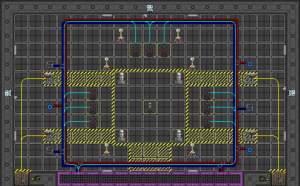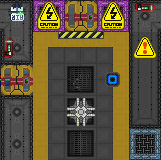Участник:Burrito Justice/Sandbox

Welcome to frick. Engine will probably kill you. Just use the SM instead.
Basic Setup
- First off, retrieve the Tesla beacon from hard storage. Put it just outside the engine room, secure it over a wire knot (that you will have to place, connected to an existing wire net), and click it to turn it on. If anything goes wrong then this device will hopefully save everyone else a lot of trouble.
- Equip a wrench and secure everything in sight to the floor.
- Containment field generators can be secured right where they are. Refer to the picture above to see where they are normally placed.
- Tesla coils must be secured on wire knots. If they are not on a wire knot then they will not output any harnessed energy.
- Emitters, too, must be secured over wire knots. They should also be facing a containment field generator.
- The tesla ball generator doesn't need to be secured. Just make sure it's within the confines of the containment field generators.
- Equip a welder and weld the following to the floor:
- Emitters
- Containment Field Generators
- Retreat to the storage area and bring out all of the grounding rods into the main engine room.
- Secure the grounding rods anywhere you like with a wrench. It doesn't matter where they are as long as they can see the Tesla when it is active.
- A good rule of thumb is to make sure all of the containment field generators are within sight of the grounding rod.
- Return to the room with the partially assembled particle accelerator. Wrench all components to the floor.
- If you accidentally bump a component out of alignment, simply push against it to face north. If you cannot push it, then pull it north by standing on its northern end and clicking your own turf.
- Click on all of the components with cable until they are all stuffed with wires. This includes the control console.
- Screwdriver the panels of all of the components closed.
- Interface with the control console and run a scan for all components. If everything is setup correctly then the PA should be ready to fire. Don't fire it yet, though.
- Move back to the engine room and set the engine room SMES (the one with the wire running out from under it to the emitters) to maximum input and output.
- Turn on all of the emitters. They should be shooting the containment field generators.
- You can swipe your ID over an emitter to lock it. This prevents someone without a valid ID from turning the emitters off and causing a containment breach.
- Click on all of the containment field generators to turn them on. Any other activated CFG in a cardinal direction from another will form a containment field between the two. You should see four fields in total.
- Do not stand adjacent to a containment field. You will most likely suffer intense burns and also be thrown into a wall.
- Also make sure you don't run in front of the firing emitters.
- The Tesla-to-be is now contained. Move back over to the PA control console, set the power level as high as it can go, and turn it on.
- If you really want, you can unscrew the panel and hack the wires to find the throttle control wire. Pulsing it with a multitool will make a grinding sound. Cut this wire to allow higher power levels.
- Eventually the Tesla will make itself manifest and things will get very loud. Keep the PA turned on until the Tesla has 18 miniballs orbiting the main body.
- You can quickly figure out how many miniballs are in play by examining the main Tesla ball.
- Assuming you brought out all of the grounding rods, you can actually shoot up to 24 miniballs. This, however, generates more energy than either SMES can utilize and is somewhat risky in case of sabotage.
- Lastly, if the Tesla isn't shooting arcs of lightning at anything and is just hugging the southern part of the containment field then you need to move the Tesla beacon back a few steps.
- Set the distribution SMES to whatever you feel like setting it to. It's the SMES that goes out to the rest of the station.
That should about cover the most basic and straight forward setup. There are, of course, changes you can make to make it more efficient or behave differently if you so desire, but they aren't wholly necessary. If, however, something has gone wrong then you better have setup that Tesla beacon correctly, otherwise you're dealing with a containment breach of more-than-annoying proportions.
Operating Principles
Like any self-respecting engine, the purpose of the Tesla is to generate power, though in SS13's case this is done through wacky, barely understood, and downright dangerous means. The idea is that a Tesla ball - after being energized with accelerated particles and manifesting - will violently arc lightning at objects that it deems must die. Thankfully some scientists figured out how to make a machine that both harnesses lightning and looks annoying enough to the Tesla to be shocked regularly while also being tough enough to withstand being electrocuted to heck and back, thus the tesla coil was born. Sometimes the Tesla becomes so powerful that not even coils can withstand its anger, so they had to make a grounding rod to eliminate the excess energy.
And then they found out that metal walls weren't very good at keeping a Tesla in place, so someone with some creative freedom decided to design the CFG network, which shoot out highly energized containment beams, and are powered by emitters of all things instead of just being powered through conventional means, making setting up the Tesla slightly more inconvenient. At least it looks important!
Containment
As mentioned above, containment is very important and will be the first thing you focus on while setting this whole thing up, because if you don't then everything will almost certainly start exploding, so you'll want to make sure you've setup everything up correctly.
 Containment Field Generators
Containment Field Generators
The containment field generators (or CFG) are directly responsible for keeping a Tesla ball contained. They must be wrenched and welded to the floor in order to function. They receive power in the form of being shot by an emitter and in turn output energized, tangible fields of energy to other CFGs in order to keep the Tesla ball from escaping or going where it shouldn't. These fields are also pretty good at keeping stuff out of the containment area as well, so good in fact that they will forcefully push away anyone who dares to stand adjacent to one, probably with enough force to send them straight through a window, so be mindful of this.
A CFG has to be turned on (by clicking on it) after it is already receiving power from an emitter. Turning one on before an emitter energizes it may make it turn itself back off automatically. They also cannot be turned off unless the emitter powering them stops firing and the CFG runs out of energy.
 Emitters
Emitters
Emitters usually only see practical use in the SM engine (unless you're already acquainted with their destructive potential regarding blobs or breaking and entering), but emitters here are what power the CFGs to allow them to contain things, namely the Tesla ball. Emitters must be wrenched and welded to the floor over a powered wire knot in order to function. The wire network must also have at least 30 kW in it in order to fire, though since there are four emitters, this means you will need at least 120 kW of power in the network. Otherwise, clicking on an emitter will turn it on and it will fire in bursts of four. Swiping your ID over the emitter while it is firing will lock it and prevent it from being turned off without swiping a valid ID on it first.
 Grounding Rods
Grounding Rods
Grounding rods are the next stage of containment. They must be wrenched to the floor, and ideally within sight of the containment area. Though CFGs will physically prevent the Tesla ball from escaping, grounding rods will make sure it stays that way assuming there's nothing wrong with how the CFGs were setup. More specifically, grounding rods will keep other equipment safe by drawing in excess power and grounding it, preventing the Tesla from straight up melting everything else. The amount of grounding rods present determines how far you can energize the Tesla. In particular, one grounding rod supports up to four miniballs of power, and you start with six, meaning you can safely energize the Tesla up to twenty four miniballs before things begin to explode, assuming you secured all of the grounding rods.
Файл:SMES.pngSMES Settings
The emitters are the only pieces of equipment dedicated to containment that actually need power from wires, so setting the SMES with the wires running out to the emitters is important, otherwise those emitters won't be running for very long, thus the containment will not hold and the Tesla will be dining on the station's machinery. And you, especially you. Containment matters more than power distribution, so it's usually safe to maximize the input value provided you're not running a low energy Tesla. Output must be set to at least 120 kW, though maximizing this value is fine as well; nothing awful will happen if you do.
 Tesla Beacon
Tesla Beacon

If you don't set this up outside then it's your fault if the entire station blows up.
Power Generation
Bzzt
The Tesla Ball
There's a priority to what gets electrocuted first. Don't leave unsecured equipment around.
Miniballs
Unga
Particle Accelerator
The PA.
 Tesla Coils
Tesla Coils
These are what actually collect power
T E S L O O S E
GOOD LUCK
Modifications
Squish
Engineering Department
| |
| Head of Department | Chief Engineer |
| Personnel | Engineer - Atmospheric Technician |
| Useful Guides | Guide to Atmospherics - Supermatter Engine - Guide to the INDRA - Guide to Thrusters - Telecommunications - Integrated Electronics |